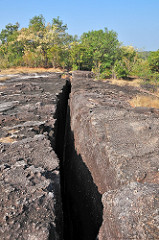
How Large is your Gap?
Posted on February 29, 2016 by Danny Windsor
 One of my main goals as I work with my clients is to assist them in having positive cash flow and becoming cash rich. Companies that are cash rich are prepared for virtually all unexpected crises and strong economic downturns. Make no mistake, there are continual cycles in the economy and the next severe downturn could be just around the corner. Companies that were not prepared during the fall of 2008 learned this principle the hard way. Ram Charan describes what happened to the automotive industry during that time, “Auto and truck sales plunged even as the companies were working feverishly to develop new models that would appeal to consumers. The reversal was so swift that General Motors announced in November that its available cash would last less than a year in the absence of a government rescue. None of the three automakers had a comfortable margin of cash on hand( emphasis mine). With dismal sales, they were not generating much cash, and a lot of that cash essentially was locked up in inventory(Charan, p.11).” Notice that much cash of the automotive industry was tied up in inventory and was a major contributing factor to their cash gap. What is the cash gap of a company and why is the knowledge of the cash gap so critical? The cash gap is illustrated as follows:
One of my main goals as I work with my clients is to assist them in having positive cash flow and becoming cash rich. Companies that are cash rich are prepared for virtually all unexpected crises and strong economic downturns. Make no mistake, there are continual cycles in the economy and the next severe downturn could be just around the corner. Companies that were not prepared during the fall of 2008 learned this principle the hard way. Ram Charan describes what happened to the automotive industry during that time, “Auto and truck sales plunged even as the companies were working feverishly to develop new models that would appeal to consumers. The reversal was so swift that General Motors announced in November that its available cash would last less than a year in the absence of a government rescue. None of the three automakers had a comfortable margin of cash on hand( emphasis mine). With dismal sales, they were not generating much cash, and a lot of that cash essentially was locked up in inventory(Charan, p.11).” Notice that much cash of the automotive industry was tied up in inventory and was a major contributing factor to their cash gap. What is the cash gap of a company and why is the knowledge of the cash gap so critical? The cash gap is illustrated as follows:
Days in Accounts Receivable + Days in Inventory – Days in Accounts Payable=The Cash Gap
Using the above formula, if your average Accounts Receivable collection days is 30, average days of inventory on hand is 45 and the average days that you are paying suppliers is 25, than your cash gap is 50 days, illustrated as follows:
30 + 45 = 75 – 25 = 50
In this example, a company needs 50 days of cash on hand or accessible ( lines of credit, etc.) to continue to operate.
The cash gap is a critical number to track and the goal should be to reduce it to as low a number as possible or to eliminate it altogether. The next crises could be just around the corner and companies with adequate cash will survive and those with thin cash reserves will fail.
*Charan, Ram, (2009), Leadership In The Era of Economic Uncertainty


